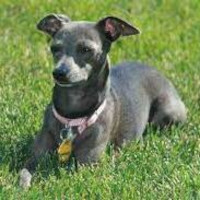 |
Italian Greyhuahua |
|
He is not recognized by the F.C.I. |
Origin |
Italy <> Mexico -> U.S.A. | |
Translation |
Francis Vandersteen |
A brief presentation of the Italian Greyhuahua |
| If you like little balls of energy, the Italian Greyhuahua may be just the dog for you. Developed from the Chihuahua and the Italian Greyhound, the Italian Greyhuahua weighs between 3.5 and 7 kilos and stands between 25.5 and 35.5 centimetres tall. They have a unique and interesting personality that makes them a special breed. This dog can make an excellent pet, but you need to make sure it is properly socialized as a puppy and well trained, as it can protect strangers. Although intelligent, this breed is a little stubborn and needs to be carefully potty-trained right away. |
History of the Italian Greyhuahua |
| The history of the Italian Greyhuahua is not well established, as the breed hasn't been around long. Therefore, you need to use the histories of the Chihuahua and the Italian Greyhound to get an idea of the breed's background. |
A little of the Italian Greyhound |
||
| The Italian Greyhound, originally from Italy of course, was bred thousands of years ago to be a hunting companion and Greyhound. They are said to have been brought to Europe over 2,000 years ago by the Phoenicians, and are even mentioned in the Bible. The Romans, Egyptians and Greeks nurtured the breed's development and prevented it from disappearing when their numbers began to decline. They were brought to the United States in the 19th century, where they were accepted by the American Kennel Club in 1886, and are now the 72nd most popular dog breed in America. | ||
 |
||
| Standard of the Italian Greyhound | ||
A little of the Chihuahua |
||
| The Chihuahua is the world's smallest dog and comes from Chihuahua, Mexico, dating back as far as 100 AD. The Chihuahua was used in Mexican funeral rituals, sacrificed to guide the souls of loved ones into the afterlife. Bred from Techichis, which were indigenous Mesoamerican dogs from 300 BC, the Toltec religion believed these little dogs were spiritual guides. Fortunately, this tradition died out before the Chihuahua became extinct, although it became very hard to find by the early 1900s. When Spanish musician Xavier Cugat began appearing with his dog, the breed became popular again and even featured in his own Taco Bell commercial. Today, the Chihuahua is the most popular breed in Los Angeles and, according to the American Kennel Club, where it has been registered since 1904, it is the 30th most common breed in the United States. | ||
 |
||
| Standard of the Chihuahua |
Appearance of the Italian Greyhuahua |
| The Italian Greyhuahua has a short to medium coat, depending on the coat type of the Chihuahua parent. Their coats generally come in a variety of colors and patterns, including white, caramel, black, chocolate, salt and pepper, red, liver, tan, blue, white, piebald, merle, spotted, speckled, sandy or brindle. These very small dogs have a small, rounded head and a compact body with long, skinny legs and huge rabbit feet. Their ears are triangular and cheerful, with round, bulging brown eyes, a black or brown nose and a long, tapering tail. They tend to have a serious, intent expression when they're not acting silly. |
Temperament of the Italian Greyhuahua |
| Your Italian Greyhuahua needs to be well trained from the start to avoid bad habits, especially with potty training. Once they've developed a bad habit, it's hard to break them. Because puppies urinate frequently, many owners use puppy pads when they're young to prevent them from going on the floor or furniture. Don't punish your puppy for accidents, but use positive reinforcement instead. When you see him getting ready to urinate, take him outside and praise him when he comes out. They are good with children and other pets, but need to be supervised with toddlers as they can be lively when frightened. |
Needs and activities of the Italian Greyhuahua |
| Both the Chihuahua and the Italian Greyhound are very active dogs and need plenty of daily exercise. Since the Italian Greyhuahua is a small dog, you can do a lot of activities with him indoors, but he also needs to go outside every day for at least an hour. Your Italian Greyhuahua loves to play with other dogs, so taking a trip to a local dog park is a great way to spend the day. Your dog may also enjoy playing fetch, practicing agility and walking around the neighborhood with you. Dogs that don't get enough exercise are prone to bad habits and health problems. |
Maintenance of the Italian Greyhuahua |
| The Italian Greyhuahua coat varies according to the Chihuahua coat. If your dog has longer hair, you should brush him at least every other day with a pin brush or firm bristle brush and a metal comb. If he's short-haired, you can probably get by with simple grooming once or twice a week with a smooth brush. You can wash him with a mild shampoo if necessary, but be sure to dry your dog thoroughly and clean his ears and teeth too. We also recommend trimming your dog's nails with a nail clipper once or twice a month. |






 English (United Kingdom)
English (United Kingdom)